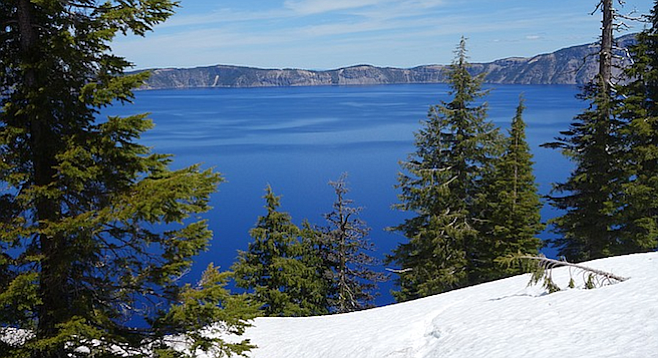Crater Lake Water
Crater Lake can be characterized as being a low total-dissolved-solids, sodium-calcium-magnesium bicarbonate-chloride-sulfate water containing less than 1.0 mg/L boron and less than 0.1 mg/L lithium. Using the 1981 east basin samples (table lb) as an example, the concentrations of SiO2, Mg, Na, K, Li, HCO3, Cl, and F and conductivity are almost identical between surface and bottom waters, and the concentrations of Ca, S04 and B are approximately the same. The concentrations of any of these constituents usually do not vary by more than the error of the determination, which generally does not exceed 10 percent.
Using the 1981 east basin surface and bottom samples again, the deuterium values are essentially identical whereas the oxygen-18 values are nearly the same. The reported isotopic values do not vary by more than 2 standard deviations on replicate samples. These data clearly indicate that Crater Lake is well mixed (figures 5 – 9). This essentially constant composition of lake water as a function of depth is also observed in the 1983 and 1984 point samples. Yearly variation, most likely analytical error, between samples is shown in figure 9. As is observed from figure 3, Crater Lake water is not on the meteoric water line, but rather plots along an evaporation line having a slope of 5, which is typical of such waters (Craig, 1961). Diamond Lake also plots along this line.
Silica analyses of Crater Lake bottom and surface water samples in 1981, point samples collected from the east basin and the southwest basin at 50 m intervals to 300 m depth in 1983, and point samples collected from the southwest basin at about 100 m intervals to the bottom in 1984 all indicate Crater Lake is well mixed with respect to silica (figure 5 – 8). Published SiO2 values of Salinas and others (1984) for 1983 samples contained lower SiO2 concentrations compared to those reported in Larson (1984, Table 5) for his 1983 samples and found for our 1984 samples. For that reason the 1983 lake water samples were reanalyzed for SiO2 . The corrected values are reported in table lb; however, they may be questionable since the redeterminations were made in 1987. The source of this error in the original values is currently unknown and tentatively is considered to be analyst error. However, the chlorophyl and dissolved oxygen values reported by Salinas and others (1984) are correct. The corrected SiO2 values are similar to those reported by Larson (1984) and the 1984 samples of the lake water (table lb).
The degree of mixing of Crater Lake, as shown by major-ion chemistry and light stable isotopes, may be clarified using the tritium data of Simpson (1970) (figure 10). Except for the near-surface samples, the tritium content of the deeper lake water is constant at 24 TU from 50 m to total depth. In the seven months previous to the date of sampling the lake, the tritium concentration of precipitation averaged 171 TU. It seems likely that this recent precipitation is the source of the peak concentration of 31 TU (figure 10). Assuming that precipitation with 171 TU was added to the lake already at a tritium concentration of 24 TU to produce the peak concentration of 31 TU, the recent-precipitation would be diluted by 20 parts of low tritium-containing Crater Lake water. This much dilution cannot be detected by the other chemical or stable isotopic data that we have, because the techniques are not sensitive enough to show it. For example, precipitation with a chloride concentration of 0.2 mg/L added to 20 parts Crater Lake water with 10 mg/L chloride would have a resulting concentration of 9.5 mg/L. This small difference is well within the analytical uncertainty of chloride determinations.


